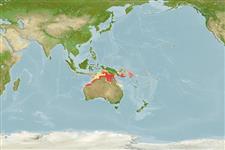分類 / Names
俗名 | 同種異名 | Catalog of Fishes(屬, 種) | ITIS | CoL | WoRMS | Cloffa
Elasmobranchii
板鰓亞綱 (鯊魚與魟魚) (sharks and rays) >
Myliobatiformes (Stingrays)
鰩目 (Stingrays) >
Dasyatidae (Stingrays)
土魟科 (Stingrays) > Neotrygoninae
Etymology: More on author: Last.
Environment: milieu / climate zone / depth range / distribution range
生態學
海洋 居於水底的; 深度上下限 5 - 80 m (Ref. 9840). 深水域; 4°S - 21°S
Western Pacific: northern Australia and New Guinea, including the Arafura Sea and Timor Sea.
西太平洋: 澳洲北部與新幾內亞, 包括阿拉弗拉海與帝汶海。
大小 / 重量 / 年齡
Maturity: Lm ? range ? - ? cm
Max length : 25.0 cm WD 雄魚/尚未辨別雌雄; (Ref. 6871)
Found on the continental shelf (Ref. 6871, 75154). Size at birth about 11 cm WD (Ref. 6871). Exists as two color forms. Ovoviviparous (Ref. 50449).
棲息於大陸棚了。 出生時的大小大約 11 公分 WD 。 (參考文獻 6871) 存在如二個色彩形式。 卵胎生的.(參考文獻 50449)
Life cycle and mating behavior
Maturities | 繁殖 | Spawnings | Egg(s) | Fecundities | 仔魚
Exhibit ovoviparity (aplacental viviparity), with embryos feeding initially on yolk, then receiving additional nourishment from the mother by indirect absorption of uterine fluid enriched with mucus, fat or protein through specialised structures (Ref. 50449). Distinct pairing with embrace (Ref. 205).西太平洋: 澳洲北部與新幾內亞, 包括阿拉弗拉海與帝汶海。
Last, P.R. and J.D. Stevens, 1994. Sharks and rays of Australia. CSIRO, Australia. 513 p. (Ref. 6871)
人類使用
漁業: 沒有興趣
工具
特別的報告
下載 XML
網路資源
Estimates based on models
Preferred temperature (Ref.
123201): 26.2 - 28.6, mean 27.7 °C (based on 312 cells).
Phylogenetic diversity index (Ref.
82804): PD
50 = 0.5039 [Uniqueness, from 0.5 = low to 2.0 = high].
Bayesian length-weight: a=0.01096 (0.00342 - 0.03513), b=3.11 (2.86 - 3.36), in cm total length, based on LWR estimates for this (Sub)family-body shape (Ref.
93245).
營養階層 (Ref.
69278): 3.4 ±0.3 se; based on size and trophs of closest relatives
回復力 (Ref.
120179): 低的, 最小族群倍增時間4.5 - 14 年 (Assuming fecundity<100).
Fishing Vulnerability (Ref.
59153): Moderate vulnerability (40 of 100).
